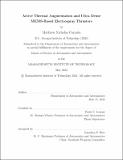| dc.contributor.advisor | Lozano, Paulo C. | |
| dc.contributor.author | Corrado, Matthew Nicholas | |
| dc.date.accessioned | 2023-01-17T18:15:50Z | |
| dc.date.available | 2023-01-17T18:15:50Z | |
| dc.date.issued | 2022-05 | |
| dc.date.submitted | 2022-06-09T16:14:06.602Z | |
| dc.identifier.uri | https://hdl.handle.net/1721.1/147138 | |
| dc.description.abstract | Ionic liquid electrospray thrusters, a highly efficient form of electric space propulsion, have several advantages over traditional chemical forms of space propulsion as well as competing forms of electric propulsion, including their unique scalability down to extremely small sizes, their use of nontoxic propellants that do not require special storage or pressurization, and their ability to be operated in a bipolar mode, eliminating the need for bulky and complex neutralizers. Electrosprays still lag behind other forms of electric propulsion, such as Hall Effect Thrusters and Gridded Ion Engines, in thrust density, a key figure of merit for propulsion systems intended for small spacecraft that have limited surface area available for propulsion systems. A path forward to ultimately improve electrospray thrust density is proposed, and proofs of concept are tested. Increasing thrust density requires accomplishment of at least one of two feats: increasing the number of ion emission sites per unit area, or increasing the magnitude of current capable of being extracted per emission site. Advances in microelectromechanical systems (MEMS) fabrication techniques have enabled the former, and an ultra-dense silicon-based ionic liquid electrospray thruster with record-breaking emitter density is tested. The densified electrospray thruster is successfully fired, exhibiting emission in the pure ionic regime and performance characteristics comparable to the state of the art. The latter can be achieved by thermally augmenting the current output of an electrospray thruster, leveraging the temperature dependence of propellant properties and fluid mechanics of propellant transport. The applications of such a system are discussed and analyzed, and a prototype for a thermally augmented electrospray thruster is designed and tested, verifying the concept of current augmentation at elevated temperatures. | |
| dc.publisher | Massachusetts Institute of Technology | |
| dc.rights | In Copyright - Educational Use Permitted | |
| dc.rights | Copyright MIT | |
| dc.rights.uri | http://rightsstatements.org/page/InC-EDU/1.0/ | |
| dc.title | Active Thermal Augmentation and Ultra Dense MEMS-Based Electrospray Thrusters | |
| dc.type | Thesis | |
| dc.description.degree | S.M. | |
| dc.contributor.department | Massachusetts Institute of Technology. Department of Aeronautics and Astronautics | |
| dc.identifier.orcid | https://orcid.org/0000-0003-2741-7829 | |
| mit.thesis.degree | Master | |
| thesis.degree.name | Master of Science in Aeronautics and Astronautics | |
